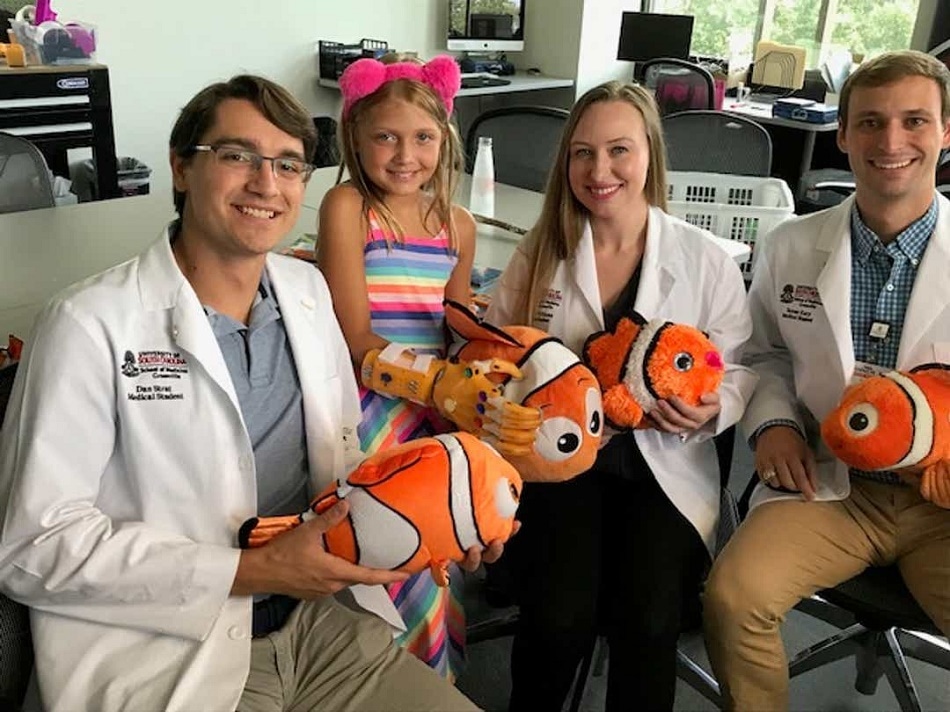 Lily Larrimer with medical students Dan Strat, Rikki Williams and Tanner Karp. Image Credit: The Greenville News
Lily Larrimer with medical students Dan Strat, Rikki Williams and Tanner Karp. Image Credit: The Greenville News
In Greenville, South Carolina, a team led by three second-year students from the University of South Carolina School of Medicine Greenville have given an 8-year-old from Simpsonville, Lily Larimer, a new sense of confidence and potential to experience the world around her.
Born with a limb deficiency in her right-hand Lily is as keen spirited as any other third grader, but when her family heard about a breakthrough program offering 3D-printed limbs to children they approached the team immediately.
Soon enough Lily was fitted with what she refers to as her “robot hand”, enabling her to do the things she would otherwise find extremely difficult or require assistance with. “She uses it a lot of the time when she requires a little extra help,” Lily’s mom explained. “It’s something that’s precious that she’s blessed to have.”
Tanner Karp, Dan Strat, and Rikki Williams are part of the Greenville Hands Up membership, a local division of national organization e-Nable, an initiative that provides children around the world with access to 3D-printed prosthetics.
Together, with the assistance of medical students Bree Baginski, Julia Prodoehl, and Zachary Reynolds, as well as Philip Ott of the School’s IT department and Brandon Lawhorn, a prosthetist-orthotist with Prisma Health-Upstate’s Center for Prosthetics and Orthotics, the team are providing a real-world approach to the development of 3D-printing in medicine. This comes with the hope that one day as well as limbs, organs can also be produced using this state-of-the-art technology.
Many believe that 3D printing is the future of medicine from orthopedics and hand surgery to pulmonology and cardiovascular surgery. The medical students in Greenville believe that the doctor of the future is one who is technology savvy.
3D printed limbs are particularly ideal for children due to the fact they can outgrow their prosthetics quickly and the current prosthetics available on the market can be of too great of a cost when considering how often children require replacements – the price of prosthetic hands is between $7,000 and $10,000 each with myoelectric hands upwards of $30,000 apiece.
A 3D printer usually costs about $5,000 with around $50 worth of plastic spent per hand. Furthermore, the acquisition of a plastic printer can act as an efficient research tool for a school like the University of South Carolina School of Medicine - in addition to hands, it can print plastic models of skulls, trilobites, and viruses. This makes 3D printed limbs affordable for families, like the Larimers, or those without the means or access to ‘professional prosthetics’.
For the creation of Lily’s unique “robot hand” e-Nable offers patients hand designs that can be customized to individual preferences and needs. Once a design has been finalized, inside the printer, plastic tubing is heated and pushed through nozzles to lay down the pattern. Individually, one thin layer after another is printed, until it begins to form the design – in this case the parts of the hand are produced individually; wrist, palm, digits with Lily's particular design having a full grasp actuated by her wrist. It took about a week to print all the parts for her hand
Although the initial design of Lily’s hand was to be in honor of her favorite Disney character, Nemo, it came to resemble the now infamous ‘Infinity Gauntlet’ that Thanos wears in the Marvel Comics series. So, in addition to a Nemo character printed onto the hand the team added some jewels so that Lily could snap her fingers and turn everybody to dust. “At recess at school, we usually pretend that I’m Thanos,” Lily said. “And I like that.”
Acknowledging that this is her first prosthetic, Lily’s parents are fully aware that it enables her to get used to the devices, and that will benefit her in the future. “It’s a great thing. It will really help Lily out,” her dad says. “I always tell her, just try and you can accomplish whatever you want.”
With the continual research and development of national organizations such as e-Nable and the local efforts of the team at University of South Carolina School of Medicine Greenville, children and adults alike will continually benefit from this affordable and accessible revolution in medicine – one that enhances lives today and could be saving them tomorrow.
Disclaimer: The views expressed here are those of the author expressed in their private capacity and do not necessarily represent the views of AZoM.com Limited T/A AZoNetwork the owner and operator of this website. This disclaimer forms part of the Terms and conditions of use of this website.